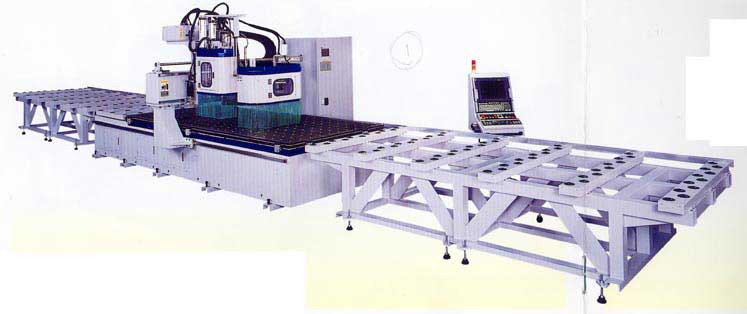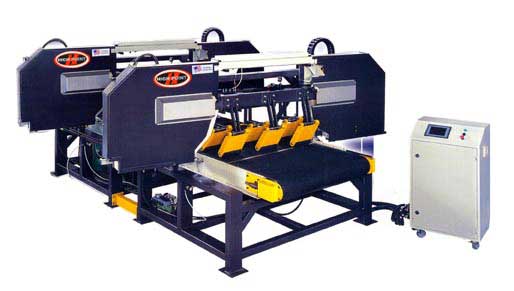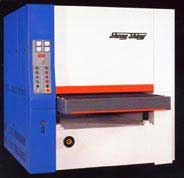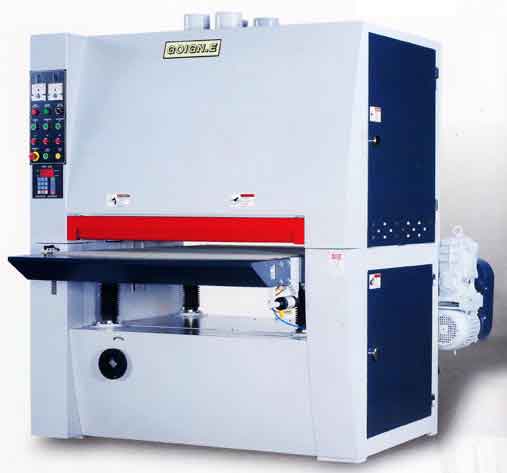Taiwan Woodworking Machinery Makers
2008/02/26 | By Ken LiuTaiwan woodworking machinery makers are feverishly trying to integrate more efficient design features into products to enhance precision, degree of automation and output, as the most savvy way to stay ahead of the competitors in mainland China is to maintain technological superiority.

Meanwhile, moving upmarket is the way to keep sales lead over mainland Chinese woodworking machine tool suppliers, because buyers seeking sophisticated machine tools are willing to pay more, hence the higher profit margins and healthier bottom-lines.
Clearly the law of supply and demand is fueling competition against Taiwan suppliers of woodworking machinery equipment. China turns out about half of the furniture worldwide, which shows heavy demands for machine tools, thus consequently fueling the development of the sector, according to Bill Hung, chairman of the Taiwan Woodworking Machinery Association (TWMA).

"The huge demand in mainland China has pushed woodworking machinery manufacturers to upgrade quickly in recent years, compelling us to stay with the competition by trying to design more efficient machines to retain existing customers, and more importantly attract new customers," Hung says.
Efficiency is a design feature that is, Hung observes, gaining popularity in many rising economies who traditionally prefer strip-down machines capable of only simple functions for their affordability, as developing economies also cannot evade the impact from global inflation that currently sweeps worldwide; while mechanical efficiency enhances productivity to save cost, a consideration sometimes overlooked by industry newcomers who are myopic due to immediate concerns such as having to cope with sudden changes in demand, volatile raw material supply, etc.
The possible worsening of the global economic slowdown, as ignited apparently by the sub-prime mortgage crisis stateside, Hung estimates, likely caused the island's woodworking machinery sector to have suffered a 7% shipment setback in 2007. "Such slowdown is particularly steep for suppliers serving the DIY segment because the United States is the world's biggest market for household machines," Hung notes.
Reality Bites
However, the chairman concedes that only 20% of the island's machinery suppliers are engaged in enhancing efficiency for practical reasons: upgrading efficiency calls for serious R&D, while such work is often rigorous, time-consuming and obviously capital-intensive. The reality is that most machinery suppliers in Taiwan simply do not have the financial clout to back up significant R&D programs. "Most efficiency-enhancement projects at domestic machinery makers focus on 'adding new functionalities' to off-the-shelf machines. To effectively keep at bay competition from the mainland, we need to focus on building highly-automated, CNC (computerized numerically-controlled) machines in the long run," he comments.
The chairman notes that the Taiwan industry's shipments have declined 15-20% over the past three years as a whole. However, its exports to rising economies have risen considerably. "Export to India, for instance, soared two folds two years ago from four years ago and would have likely risen 50-60% in 2007 from a year earlier," Hung estimates.
Over the past five years, Hung says, the Association has led its members to painstakingly tap the potential opportunities in the rising economies, including the former Warsaw Bloc. "We have reaped some returns with our efforts in these Eastern European nations," he notes. Hung says that a good starting place for Taiwan machinery makers in Europe is the east, where the automated woodworking machinery sector has long been dominated by German and Italian suppliers. Taiwan is the world's No.3 woodworking machine tool supplier with annual average export revenue of NT$28 billion (US$848 million at US$1:NT$33), after Germany and Italy.
Hung, besides being the trade association chairman, also owns Boway Technology Co., Ltd., and has begun turning the efficiency-enhancing program into reality: introducing a family of CNC machining centers capable of milling, sawing and boring non-metal workpieces, including wood and plastic. "These machines are particularly sought-after by manufacturers in industrially-advanced economies where labor costs, a major burden on the balance sheets, are typically higher than those in less-developed nations," he says.
Boway has been known for machines designed to polish wooden products since it opened in 1988. Prudently adopting M&A as strategy, the company has been working with a local CNC-machine manufacturer and eventually acquired it in 2007, effectively enabling Boway to reposition itself, and more importantly move upmarket. Hung stresses that the acquisition is a prudent move on two-fronts: one is that the CNC-machines command higher profit margins, hence placing Boway in a better revenue position, and the other is that the more sophisticated machines have opened a much needed door, offering more breathing room, through which Boway can escape the crowded market and competition.
The company's latest CNC machines are coded BWM-C481AE, BWM-C481A, BWM-C5101A, BWM-C5121A+2R, and BWM-C5121A.
The C481 family is equipped with a vacuum worktable measuring 1,220mm x 2440mm, a triple-axial-enabled spindle, a tool magazine with maximum storage capacity of eight tools, a drum-type automatic tool changer capable of a lightning eight-second-a-tool switchover, a 10-HP vacuum pump, and an 11-HP spindle motor capable of rotational speed from 1,000 to 24,000 RPMs.
Spindle of both C481 models moves 60 meters a minute along X and Y axes and 20 meters along Z axis.
Made for Complications
Both C481 machines are ideal tools for producing complicated pieces, including cabinet doors, solid wood doors, computer desks and panel furniture with maximum thickness of 200 millimeters.
However, there are some differences between C481AE and its cousin. C481AE comes with double-guide, two-side drive structure while the other C481 is equipped with triple-guide, one-side drive design. C481AE is designed for economical production while C481A is for heavy-duty production. Also, C481AE has a laser light curtain system for safety.
Except for its 1550mm x 3050mm table and 15-HP vacuum pump, C5101A has many features in common with C481 family. This machine is also for heavy-duty production purpose and has an electronically-controlled pedal pad designed for safety purpose. This machine's spindle also moves along X, Y and Z axes.
C5121 family is a collection of biggest machines compared with the other two families, coming with 1550mm x 3650mm table and 20-HP vacuum pump. It also shares many features with the other two. For C5121A+2R, front-roller and back-roller conveyers for transmitting workpieces are dedicated equipment.
Whichever types they are, these machines' vacuum working tables are available by two halves, with one half carrying workpiece being processed while the other carrying feeding materials waiting for processing. "This design largely boosts production efficiency because you have materials standing by all the time," Hung explains.
All of these machines share several common precision components including a rotation-type ball screw system, a bevel-gear transmission mechanism, pneumatic boring unit, a CNC controller, a vacuum suction system, a water removal device, and a workpiece positioning unit.
The controller system, the brain of these machines, is outfitted with a 10.4-inch TFT-LCD screen, 2 gigabyte of memory, Chinese/English conversion software, layout display function, and RS-232 and DNC transmission function. The water-removal device ensures removal ratio of 99.9% on working table.
Going Quadra-Axial
Hung reports his company is ready to supply four-axial machines and allows customers to specify the exact number of processing tables. "Offering friendly design and service is the heart of our strategy for quickly moving in the market," he notes.
Manufacturers of non-metal products catering to industrially-advanced markets have been included in the company's marketing list. "Soon, rising economies will become the major markets for CNC machining centers for their growingly important roles as world workshops," Hung analyzes.

The chairman adds that CNC woodworking machines have growing popular among Taiwanese furniture manufacturers because of their impressive efficiencies and falling prices. "A typical CNC router, for instance, is priced at around NT$2 million [US$64,000] apiece now, about 10% less than in five years ago," he says.
Blue Steel Machinery Co., a leading Taiwanese maker of horizontal-type band resaws, has recently branched out into manufacturing of resaws for cutting parquets from specialization in lumber resaws and added many efficient designs to its machines.
Its new machines include HP-1000P and HP-1300-2 models. "The saw blades on these machines are designed to cut wood at 10-degree slants, making the cutting much neater and smoother than zero-degree movement," stresses company chairman Roger Yeh. He adds that cutting at a slant allows the blade to saw through wood at more than 15 centimeters per second.
Reducing Waste is Key
Yeh stresses that waste reduction is now a key design criteria for saw systems. "Since waste has to be disposed of and hence incurs 'cost' in more ways than one, so no equipment users like to see too much waste generated from cutting," he explains. Accordingly and actually enhancing efficiency, the company builds machines that turn out nearly-finished surfaces, which simply need sanding instead of extra, hence at added cost, finishing such as planning, etc. Towards this end, the company applies refined-tooth tungsten-steel saw blades from a well-known U.S. supplier to its machines. "As a result, the company's machines leave tolerance error of only plus and minus 0.2 mm on the cuts," boasts Yeh.

Slim saws allow the company's machines to slice wood pieces to a minimum 3mm in thickness. Cutting width ranges from 300 mm to 400mm, 600mm, 1,000mm and 1,300mm. 250mm is the maximum height of the workpiece the company's machines can process.
Both HP-1000P is equipped with a 30-HP motor whereas the other one is powered by two 30-HP motors. HP-1000P comes with two dust hoods in diameter of 4 inches while HP-1300-2 is equipped with four hoods in the same size. Feeding speed on the two machines is tunable, with maximum reaching 12 meters per minute.
The two machines are outfitted with several precision components, including a piloted check valve for keeping elevation-wheel positioning accurate, a saw wheel elevation activated by two hydraulic cylinders on each side of the conveying belt, a wheel positioning compensation mechanism for assuring the accuracy of wheel positioning with two magnetic scales, and PLC control unit featuring touch screen.
Also, infeed and outfeed pressure rollers fixed on buffering cylinders and rigid blade tension beam fastened to wheel helps to significantly boost processing precision.
Individualized Frequency Inverter
Each of the machines' saw heads is controlled by individual frequency inverter, allowing the heads to change speed at varying rates.
HP-1000P and HP1300-2 are CE certified. HP-1300-2 is now protected by U.S. patent. The patent is only one of the company's 40-some, mostly registered in the United States, Taiwan and mainland China.
Yeh notes hydraulic elevation system replaces screw gearbox as the major elevating power in the machines because hydraulic system can enable elevation faster than gearbox, as well as needing minimal maintenance.
Blue Steel's top three markets are the United States, mainland China and Russia. Yeh reports his company outdoes the German and Italian suppliers in Russia's low- and middle-range markets. His company markets machines in the United States through affiliate High Point Tools Corp. According to Yeh, High Point is now the No. 2 American brand of horizontal band saw system and Blue Steel is the only horizontal-type band saw supplier in Taiwan.
Yeh points out some suppliers of horizontal band saws have emerged in mainland China, but their quality level remains low and, thus still not a threat to his company. "Our machines deliver eight times the output efficiency of theirs. Ours are far more efficient: needing only two workers to handle rather than the typical four," he reported.
Specializing in sanding machines, Jun Shiau Machinery Co., Ltd. will roll out a CNC unit this summer. The company's sales manager, James Lin, stresses that the new machine can do precision sanding on corrugated boards due to its computer control unit and positioning system. "The machine sands not only the two major surfaces but also the four edges," Lin notes. He adds that boards measuring 1.3 meters wide by 120 mm thick is the maximum the machine can handle.
To let the machine work on corrugated boards, the company outfits this machine with a "piano key" mechanism, which allows sanding heads arranged in a line to smoothly ride up and down across the wavy surface like piano keys being played-dipping and rising. "This mechanism makes sanding material-efficient because the downward tension of the heads adjusts automatically-in effect 'evening out' or minimizing the pressure of the sanding action on non-planar surfaces, hence minimizing the waste generated," Lin explains.
Programming a Major Challenge
Lin believes his company is the first Taiwan sander maker to introduce this type of machine, which he notes was first introduced by European equipment manufacturers worldwide. "The toughest challenge in developing this machine is the software programming. However, our programming professionals successfully overcame the difficulty and even completed the task without third-party help," Lin reports.
He says this machine is ideal for sanding solid wood boards, median density fiber (MDF) boards and lacquered boards.
Although the company will promote the new machine worldwide, Lin thinks rising economies offer more opportunities than developed economies for such machine. "European market is controlled by local manufacturers there and the American economy is turning weak. In contrast to the West, rising economies are looking good and demand for automated machinery has picked up in recent years," Lin says. However, he concedes that his company's machine will definitely encounter competition posed by European-made equipment in these markets. "Our competitive edge lies in affordability and good quality: our machines are around 40% better priced that theirs," Lin says.
Lin pointed out that more sanders are purchased than any other woodworking machinery. "Accordingly and unsurprisingly, the number of newcomers in this segment has increased at an amazing pace. In Taiwan alone, there are around 20 suppliers. In mainland China, there are thousands," Lin estimates.
China, Lin said, has been catching up fast to Taiwan, while it is already able to develop relatively mature entry-type machines.
Traditionally the challenge in designing sanding machines has been to build functionality that enables the easy finishing of various woods, according to Lin. "The development is dictated by users' cost concerns. In the past, one machine typically could only handle finishing only one material type, which is clearly inefficient in this world of fierce competition where multi-tasking is virtually a prerequisite to staying afloat in resource-challenged scenarios, and an excellent way to stay ahead in established operations," he explains.
Made for Big Jobs
A typical model of the versatile machine at the company is its SD-family machines, whose sanding belt is 75 inch, 83 inch and 103 inch long depending on type. These machines, Lin stressed, are for big work-pieces. Each of these machines is equipped with two to three sanding units to ensure optimal sanding results and has maximum sanding width ranging from 600mm to 1,300mm.
"A good sanding machine can perfectly finish the surface of wood pieces so you don't have to apply too much varnish on the pieces to deliver a smooth effect. Moreover, a well-designed machine will prevent the sanding belt from wearing out too fast," Lin stressed.
The company was founded 30 years ago and worked with the government-backed Industrial Technology Research Institute (ITRI) in 1995 on new-generation sanding machines. The company distributes its line under the brand name "Sheng Shing," and has earned, due to offering reliable quality, the Canadian Standards Association (CSA) certification in 1995, CE mark in 1997 and ISO9001 in 2002.
Sander Specialist
Goign.E Machine Co., Ltd., which specializes in sanding machines, has recently added several advantageous designs to its machines. One such design criteria is an auto-emergency-liftoff: where the sander heads, as soon as encountering glitches such as broken belts, immediately separates from workpieces to stop over-sanding. "Although each machine is integrated with a braking system to immediately stop sanding in case of emergency, the braking action, which if not designed to separate the sanding head from the workpiece, will not stop the sanding from damaging workpieces," says Roger Lou, the company's general manager.
Lou has been in the industry for over 25 years and his company's machines are built specifically to produce furniture, one-piece wood panels, parquet boards and veneer-finished boards. "I believe my company has the widest range of this machine among the five or six domestic manufacturers," Lou boasts.
The "Elegant" family of wide-belt sanders is the company's signature products, designed to work up to widths of 24 inches, 36 inches, 42 inches, and 52 inches, and a maximum of five and six inches board thicknesses. This family of machines is outfitted with various specifications of motors, with 7 1/2-HP being the lowest and 30-HP the highest.
Aside from the separator, Elegant machines are also equipped with several advantageous components, including an automatic belt tracking unit, a feed conveyer whose speeds vary, a easy-to-use central control panel, a sensitive belt control, a touch-to-stop emergency bar, a convenient gauge for workpiece thickness, and a slick braking system.
Lou stresses that his company specializes in bespoke, as typically referred to in Queen's parlance or made-to-order, as spoken in non-British English, but low-volume contracts. The company mostly distributes its products to Europe, the United States and Asia, mainly under customer-specified brands. The line is CE and CSA approved, attesting to its safety quality.




